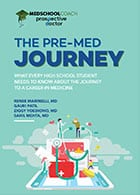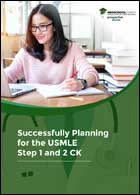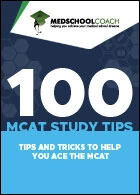
Table of Contents
The AACOMAS (The American Association of Colleges of Osteopathic Medicine Application Service) is the centralized application service used by colleges of osteopathic medicine in the United States. All premeds applying to osteopathic schools must use AACOMAS to submit their primary and secondary applications.
Important AACOMAS dates:
- May 5, 2025 — AACOMAS opens for the 2025/26 application cycle
- June 28, 2025 — Latest date to take the MCAT in 2025 (we recommend a test date in May or earlier, if possible)
- June 21, 2025 — Latest estimated date to take the Casper or AAMC PREview exam, if required by your institution (see the latest Casper schedule here and the PREview schedule here)
- January-March 1, 2026 — Application deadlines for most DO schools fall here (but don’t wait to apply until the deadline is close!)
Are you also applying to MD schools or any medical programs in Texas? Check out our guides to AMCAS (allopathic schools) or TMDSAS (Texas medical programs).
I’ll walk you through what to expect when submitting a primary application through AACOMAS, including a step-by-step guide with screenshots.
Students who work with MedSchoolCoach through the medical school admissions process DOUBLE their chances of acceptance. Find out how we can help you get accepted!
AACOMAS Application Timeline
Ideally, you’ll prepare months in advance to submit an application via AACOMAS. Here’s the timeline we recommend to typical students for your best chances at being considered in the 2024/25 application cycle:
September-December 2024:
- Plan a comprehensive MCAT study schedule and prepare for the exam.
- Check in with your pre-med advisor to ensure you’re on track to meet all the prerequisites you’ll need.
- Begin contacting evaluators you hope will provide you with letters of recommendation.
- Research the specific DO programs you want to apply to. Use our free MedSchoolExplorer to discover which programs are perfect for you!
- Consider any extracurriculars (including clinical work) that you plan to complete to strengthen your application.
- Request your official transcripts from all undergraduate schools you’ve attended.
January-May 2025:
- Create an account on the AACOMAS website. Log in or create your account here.
- Complete the Personal Information section of the application.
- Fill out High Schools Attended, Colleges Attended, and Transcript Entry in the Academic History section. Note: AACOMAS offers a Professional Transcript Entry (PTE) service that you may pay to use if you don’t want to enter all of your own coursework.
- Complete the Evaluations section (in Supporting Information) with a list of your letter writers. Check in with your evaluators to ensure they received the request via email. Schedule times to follow up with them after a period of time has passed if their evaluation hasn’t been submitted.
- Start drafting your personal statement.
- Take the MCAT early enough to get your scores back by the end of June. Contact AAMC to request your MCAT scores be sent to AACOMAS (this takes about 10-12 days).
- Schedule your Casper or AAMC PREview exam if required by your chosen school(s).
- Request your schools send your official transcripts directly to AACOMAS. Resolve any holds due to financial or other issues as quickly as possible.
June-August 2025:
- Submit your application via AACOMAS after filling out the remaining sections (such as Personal Statement, Experiences, and Achievements).
- Keep an eye on your application’s verification status. Verification should take around 10 days to complete. If your application has a significant number of errors, it may be “undelivered” and sent back to you to correct.
- Download a completed copy of your primary application.
- When requested, submit secondary applications no later than the end of July.
From September 2024 through February 2025, you may receive requests to interview at one or more programs. Some schools operate on a rolling admissions process, meaning they accept students right away who successfully complete interviews. Others may wait until all interviews are complete before sending acceptance letters as late as March 2025.
Read Next: 2025/26 AMCAS Application Timeline
How to Fill Out the AACOMAS Application
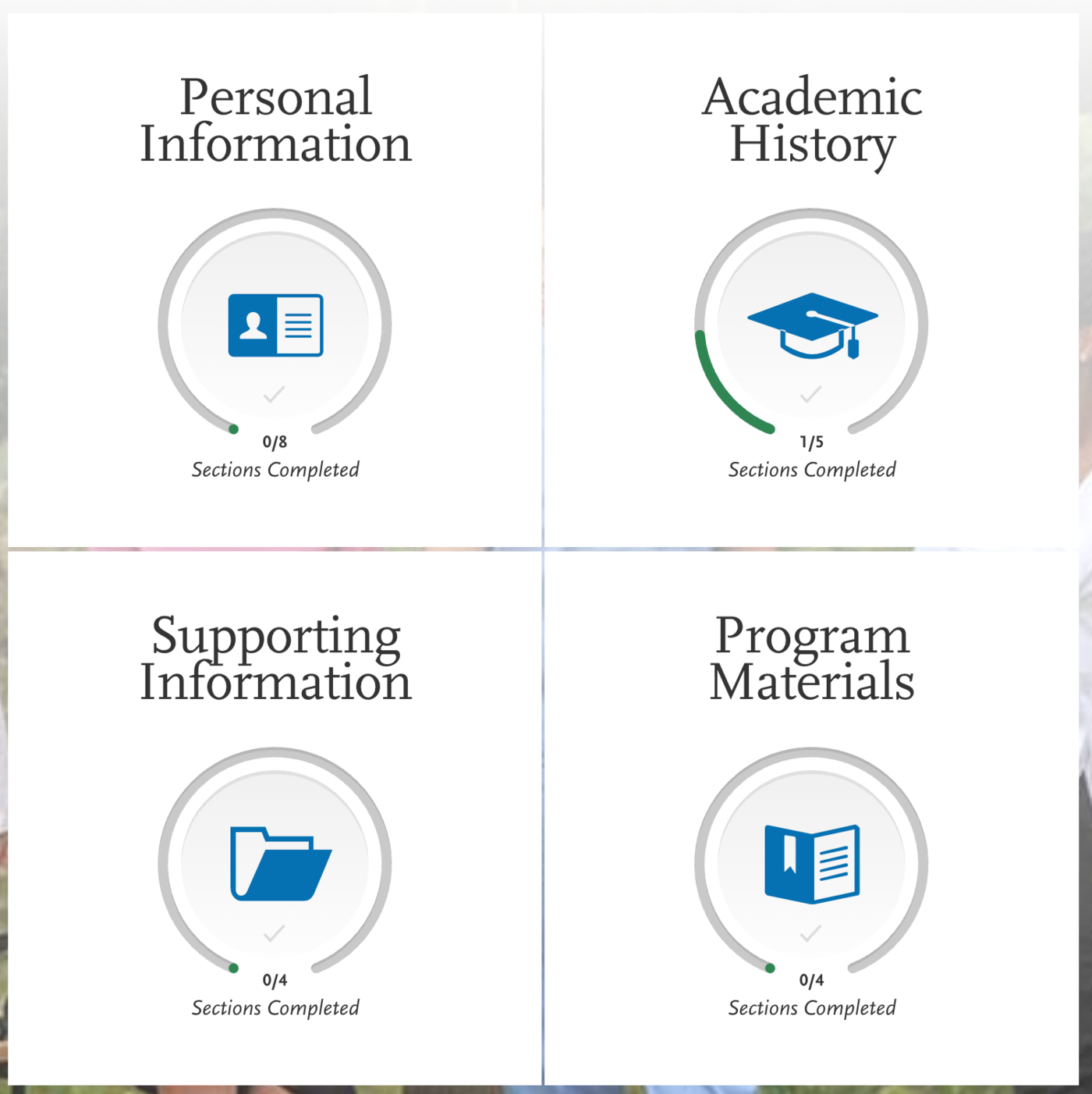
There are 4 sections on the AACOMAS primary application, each with various sections. Here’s what you can expect when completing each section.
Note: Do not attempt to fill this application out on a mobile device. Use a desktop or laptop computer or tablet with a large screen to ensure webpages all display correctly. You must use a Google Chrome or Firefox browser — other browsers may cause problems with the application experience.
Section 1: Personal Information
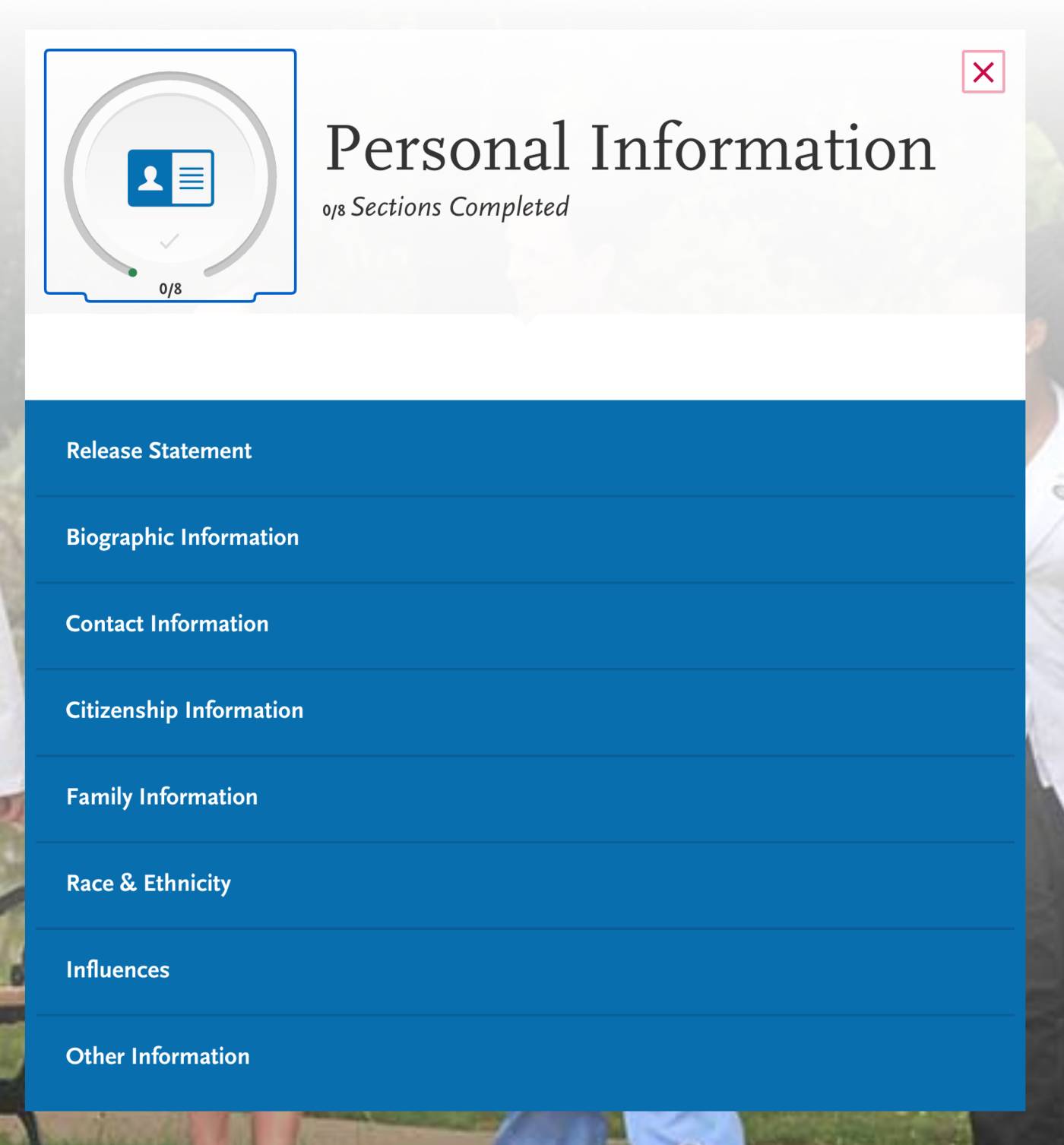
There are 8 tabs to complete in the Personal Information section:
Release Statement: You’ll start by signing a contractual agreement that states you agree to comply with the AACOMAS Applicant Help Center information. As with any legal form, read it through carefully before agreeing.
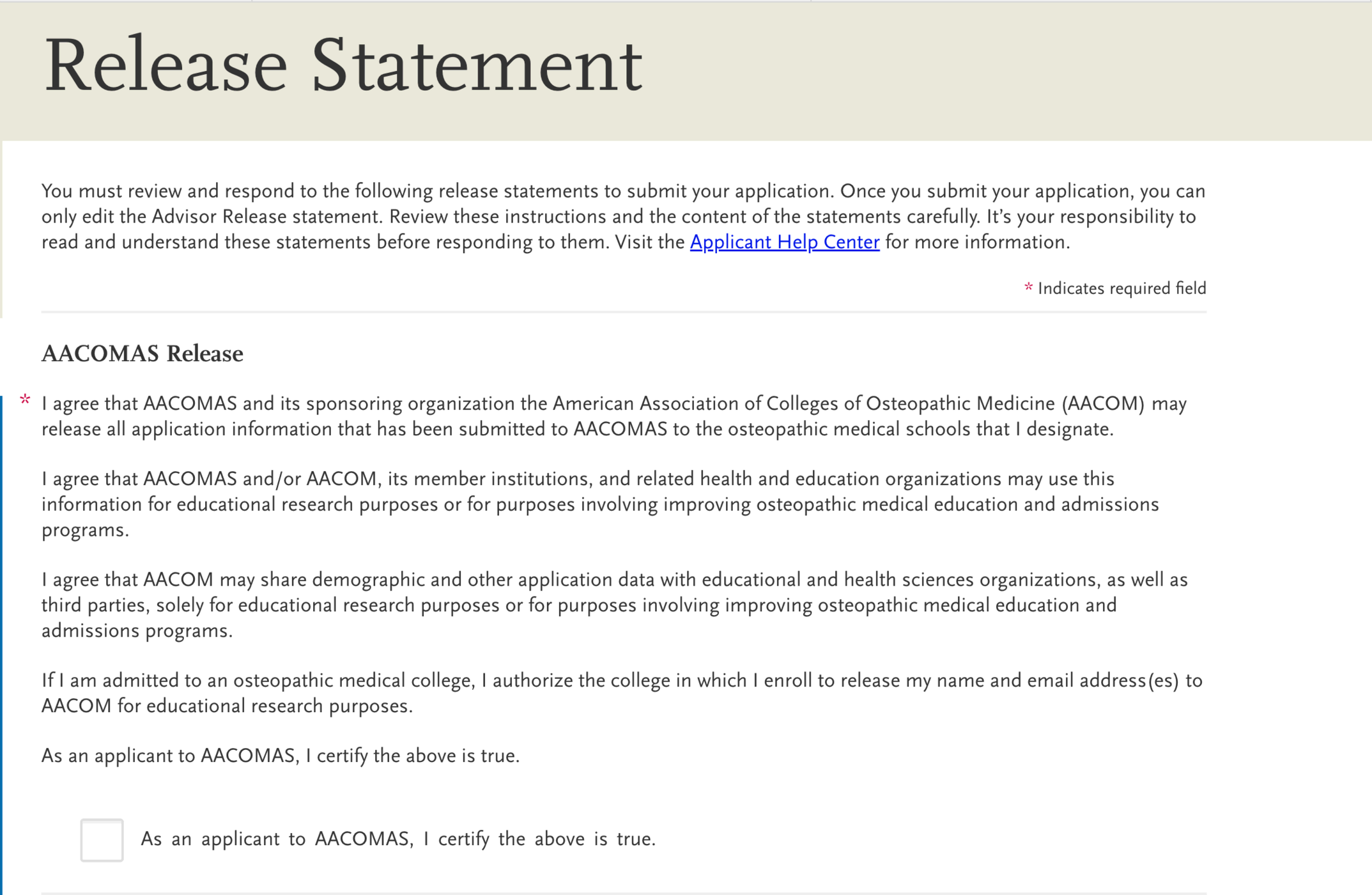
Biographic Information: Fill out your legal name, sex, gender identity, and birthdate. You’ll use this section to give any former legal names on any materials used for this application. You may decline to state your sex. Be sure to use the MM/DD/YYYY format when entering your birthdate.
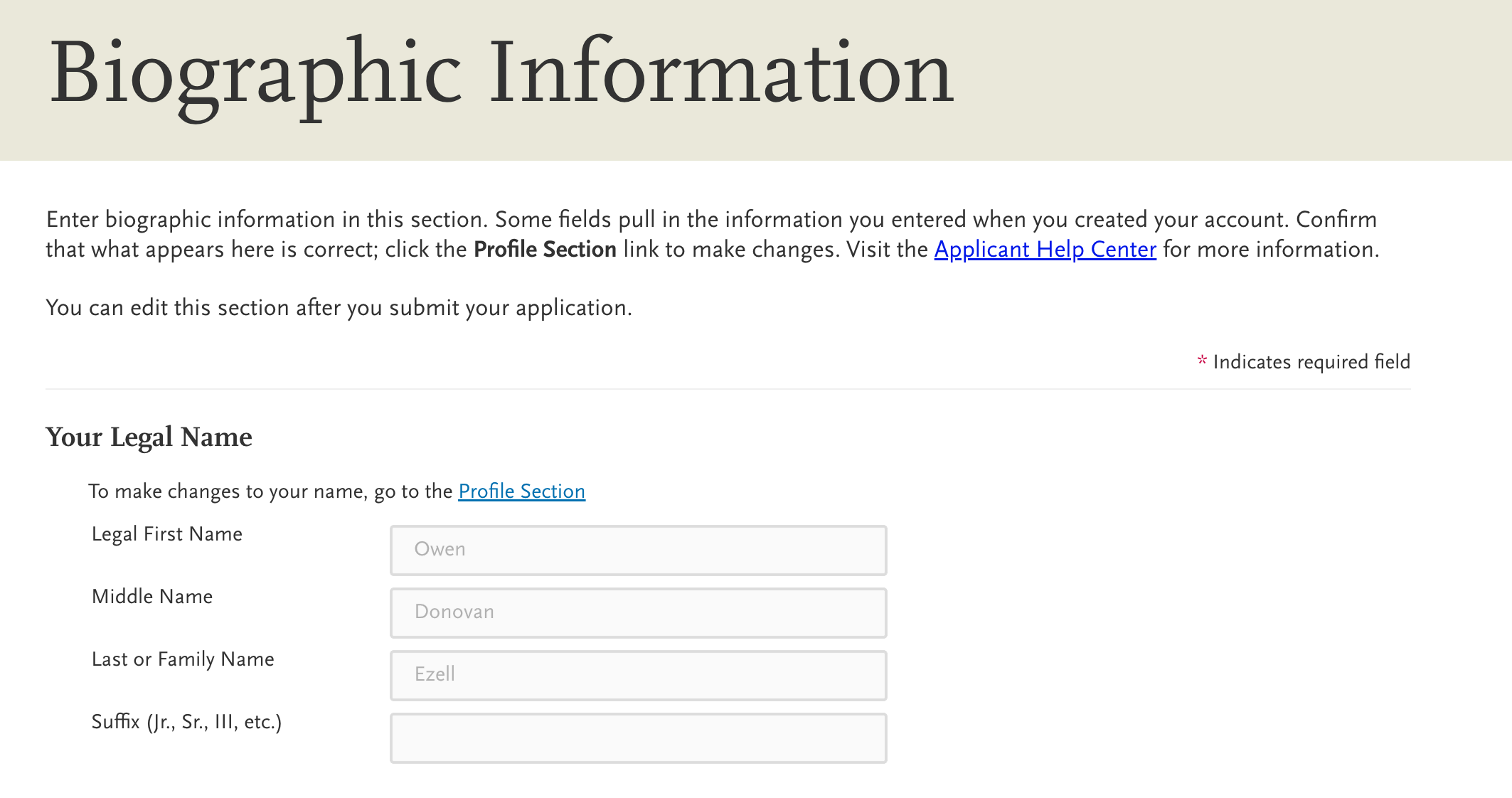
Contact Information: Provide your current and permanent address, email address, and phone number.
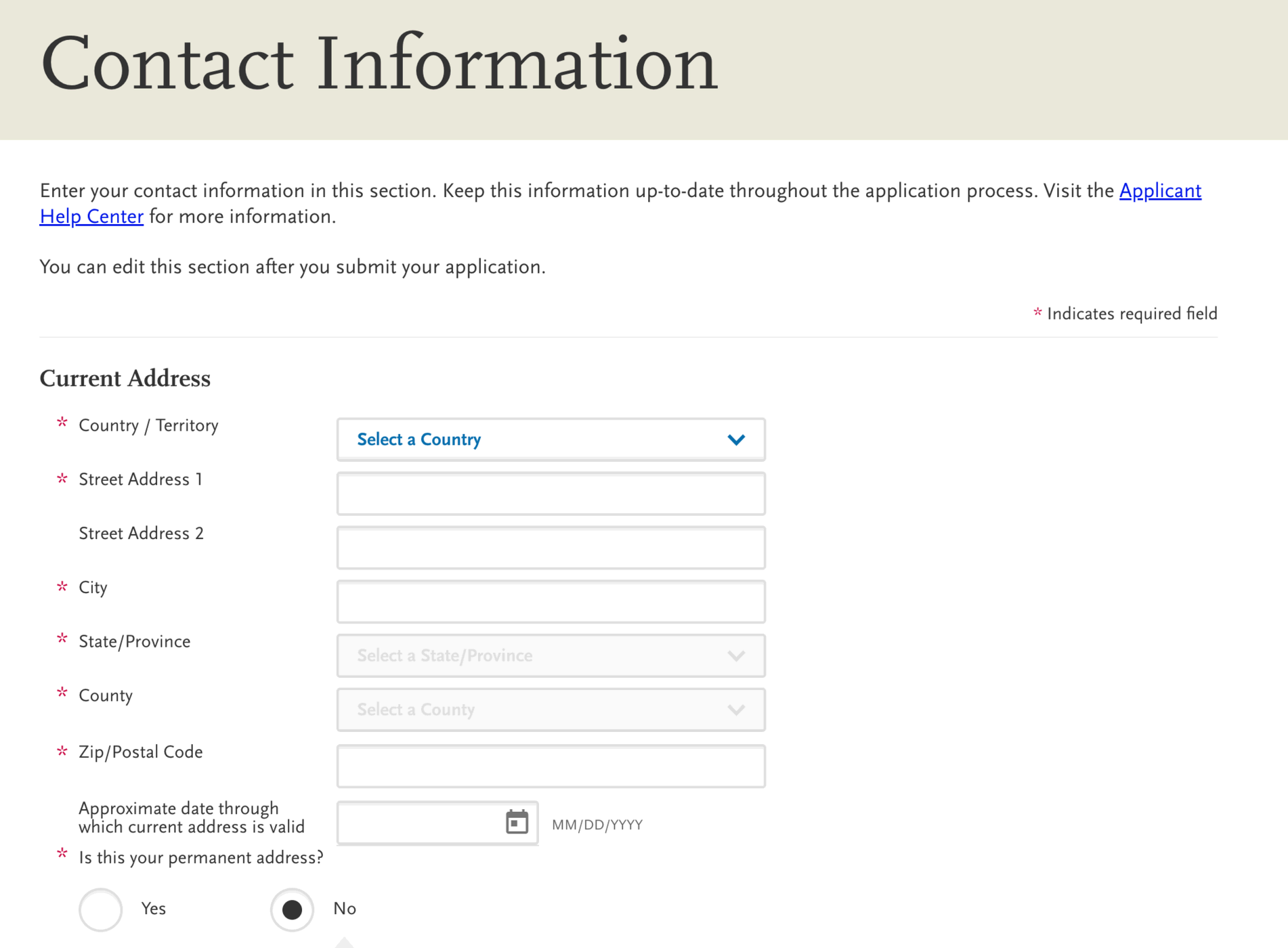
Citizenship Information: State and provide proof of your citizenship status and legal state of residence. Dual citizens should give their additional country of citizenship. Applicants on a visa will provide relevant information related to their visa.
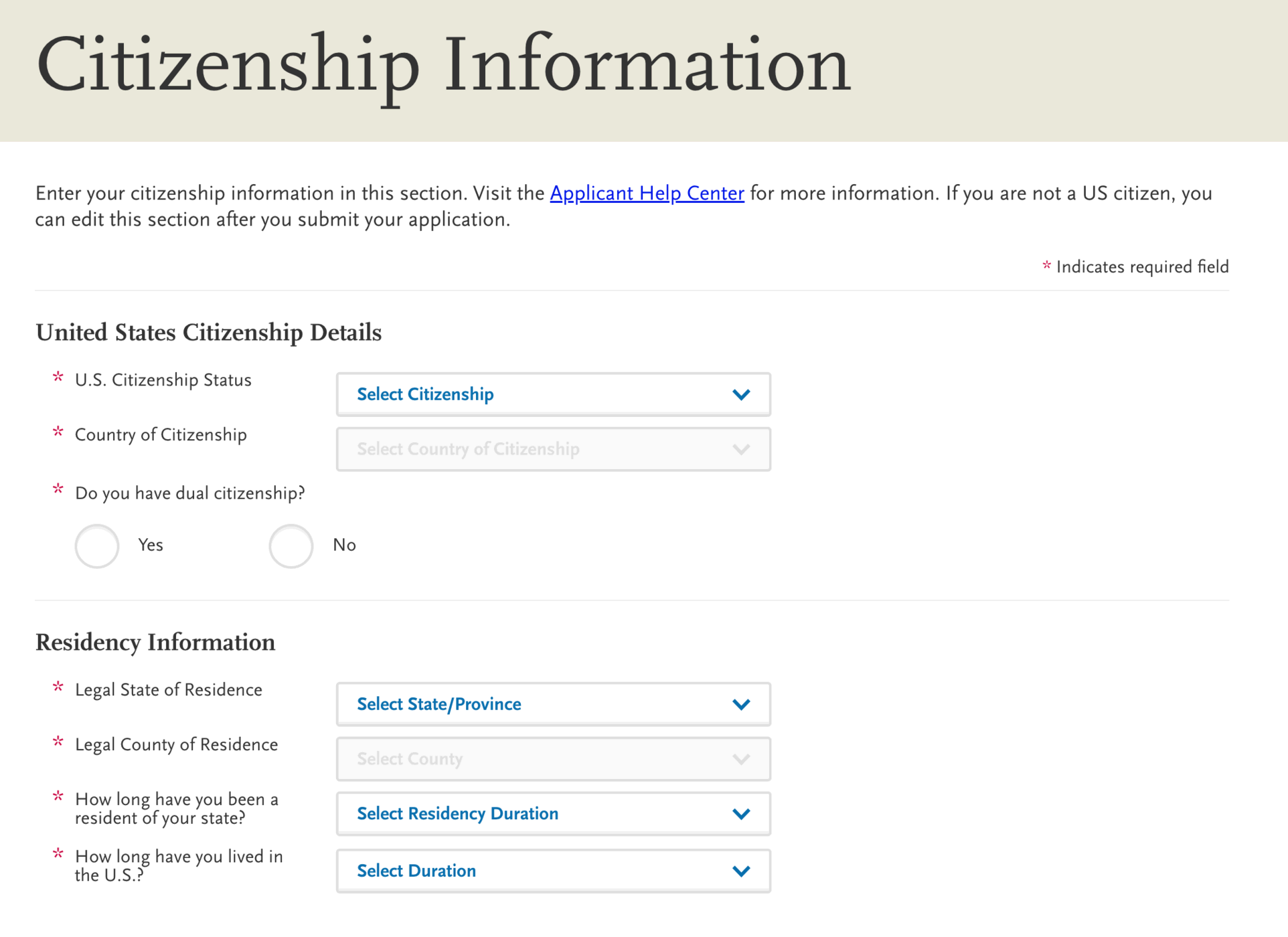
Family Information*: Fill out basic information about your parents/guardians, including residence location, occupation, education level, and household role. You will have the option to select whether a family member is living, deceased, or if you are unsure.
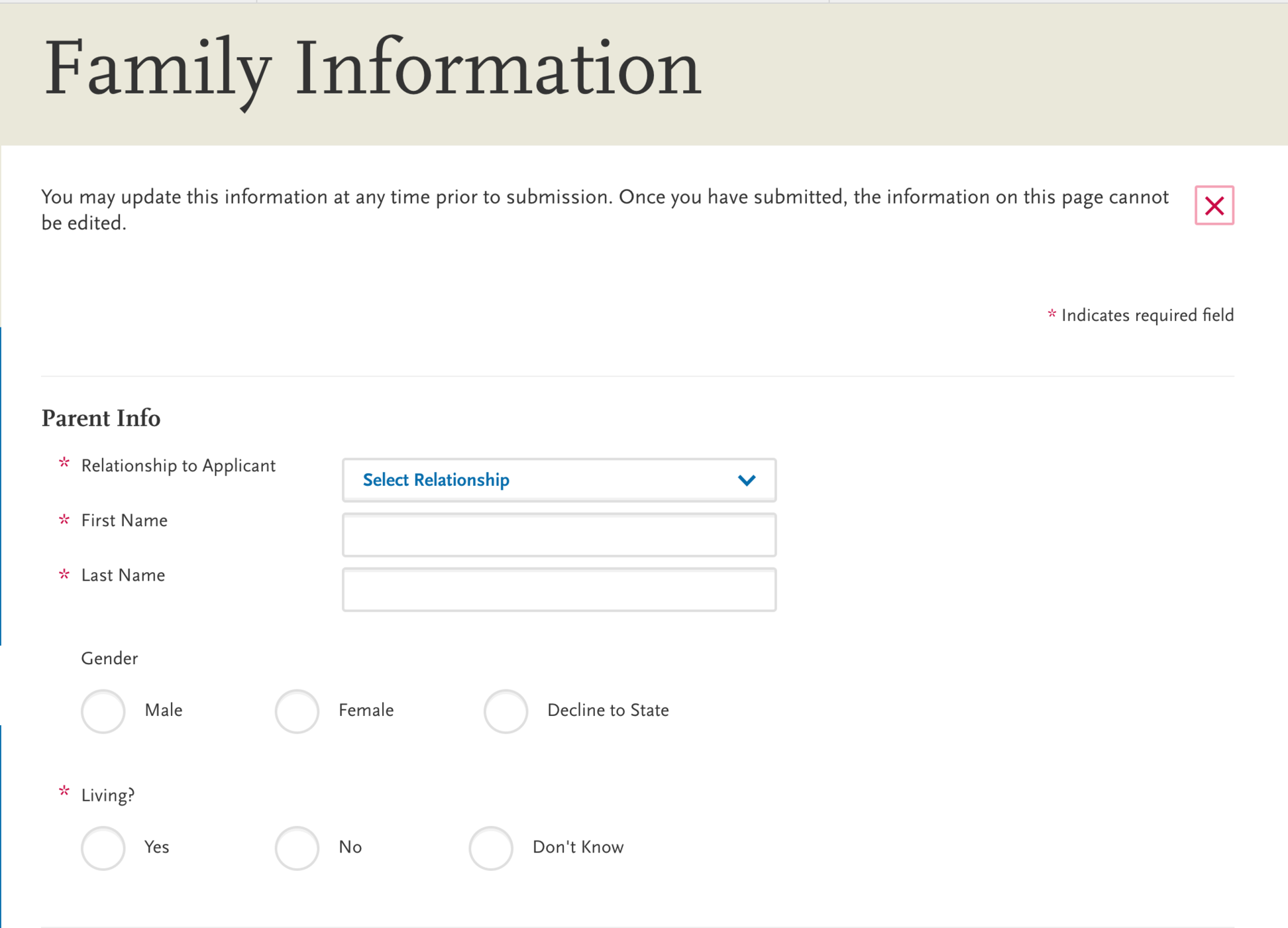
Race & Ethnicity*: Select your race and ethnicity.
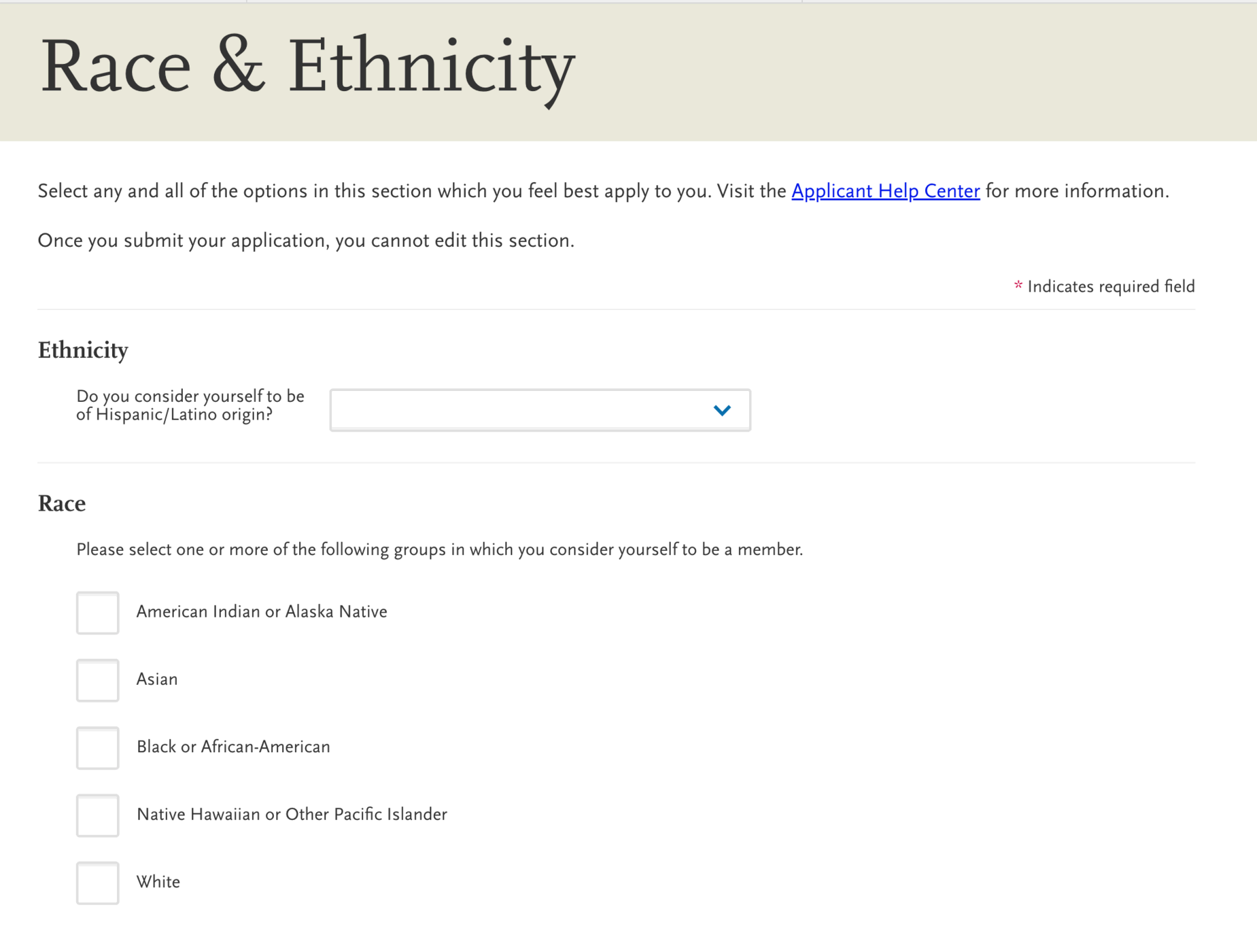
Influences: Use this section to describe why you’re interested in osteopathic medicine and prior career experience. If you have any MD or DO family members, you’ll provide information about them here, including your relationship, first and last name, school attended, and graduation date.
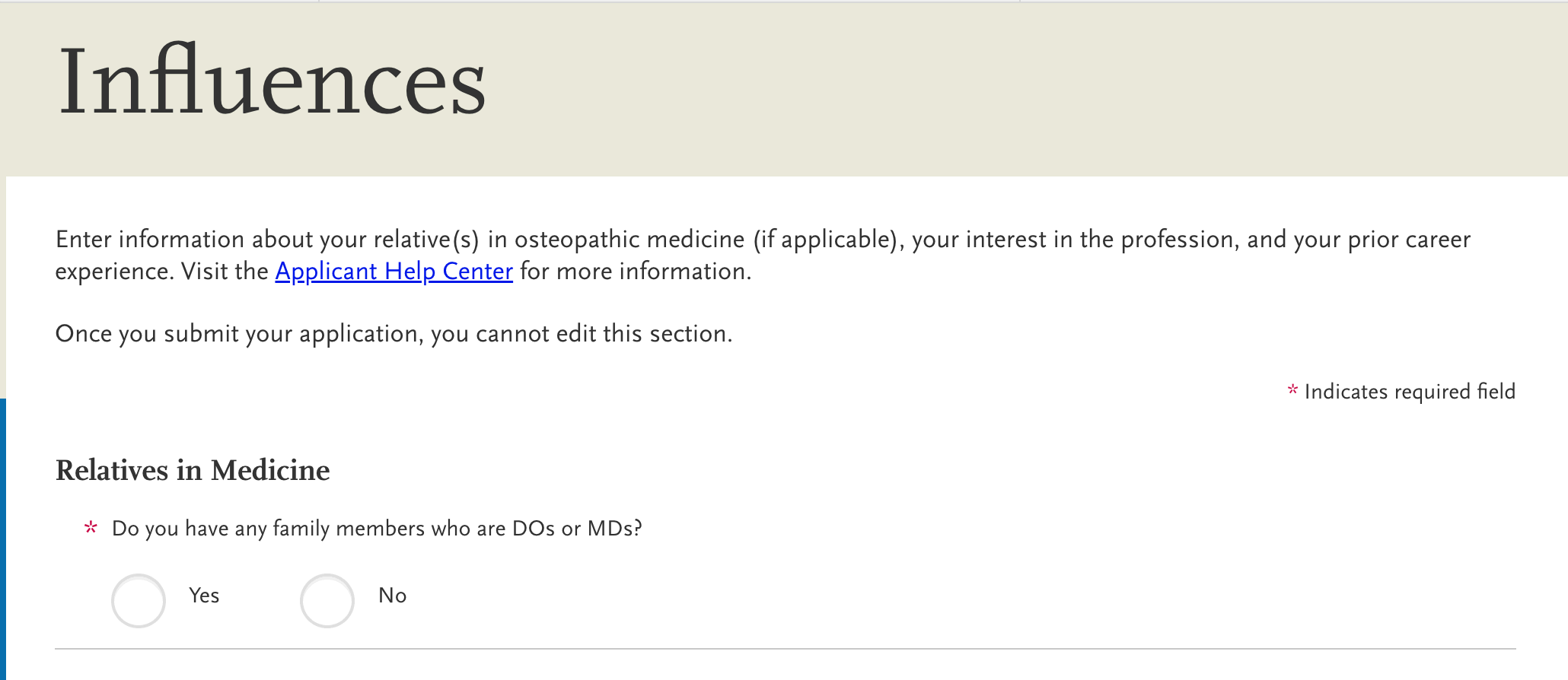
Other Information: You’ll fill out miscellaneous information in this section, including when you plan to apply to osteopathic school, your military status, what languages you speak, your social security number, background information about yourself, and criminal convictions. You’ll also enter your AAMC ID number in the “MCAT Scores” section of this page so that your scores can be matched with this ID and your date of birth (in Biographic Information).
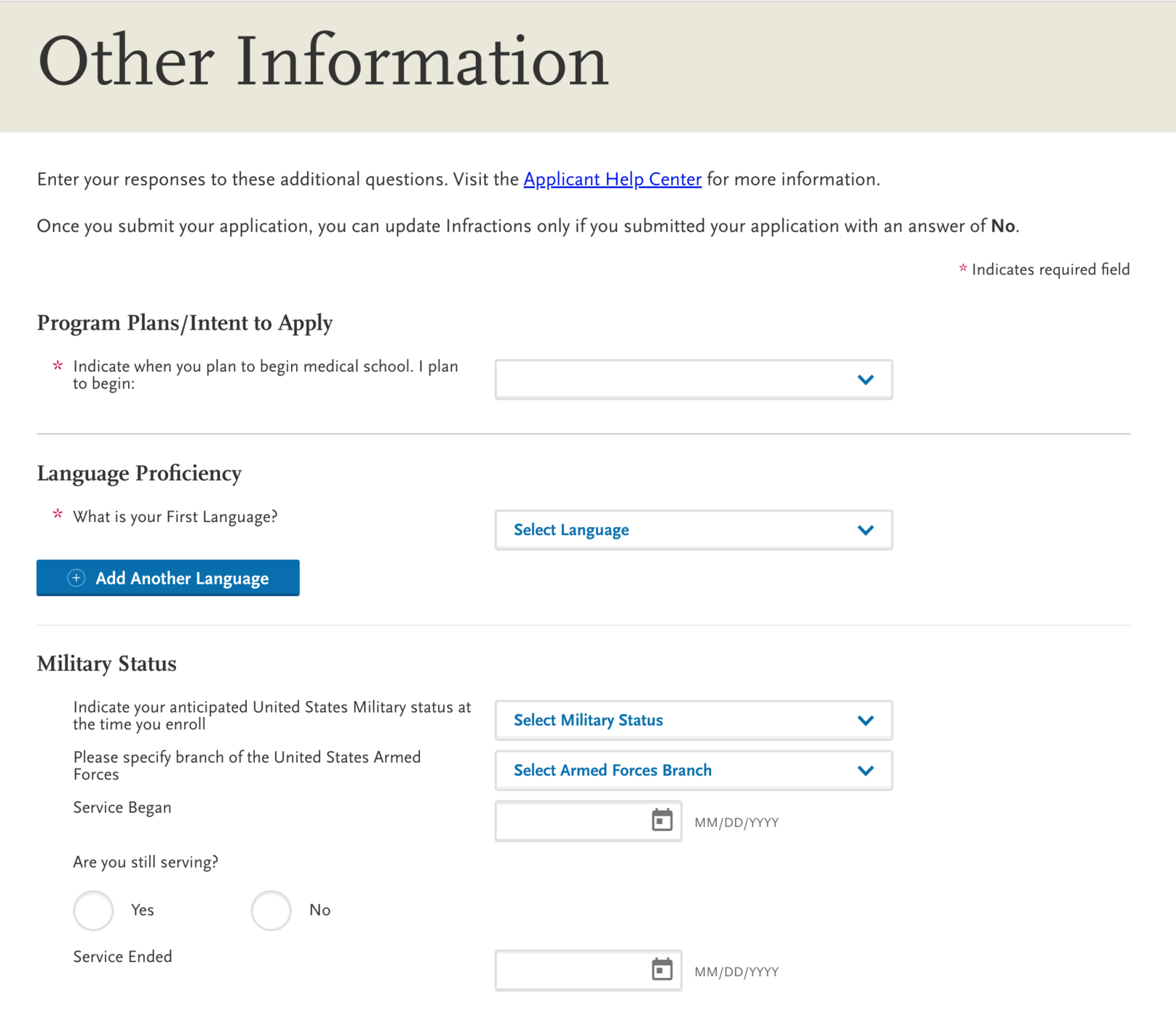
*Information in this section is optional and may be left blank.
Section 2: Academic History
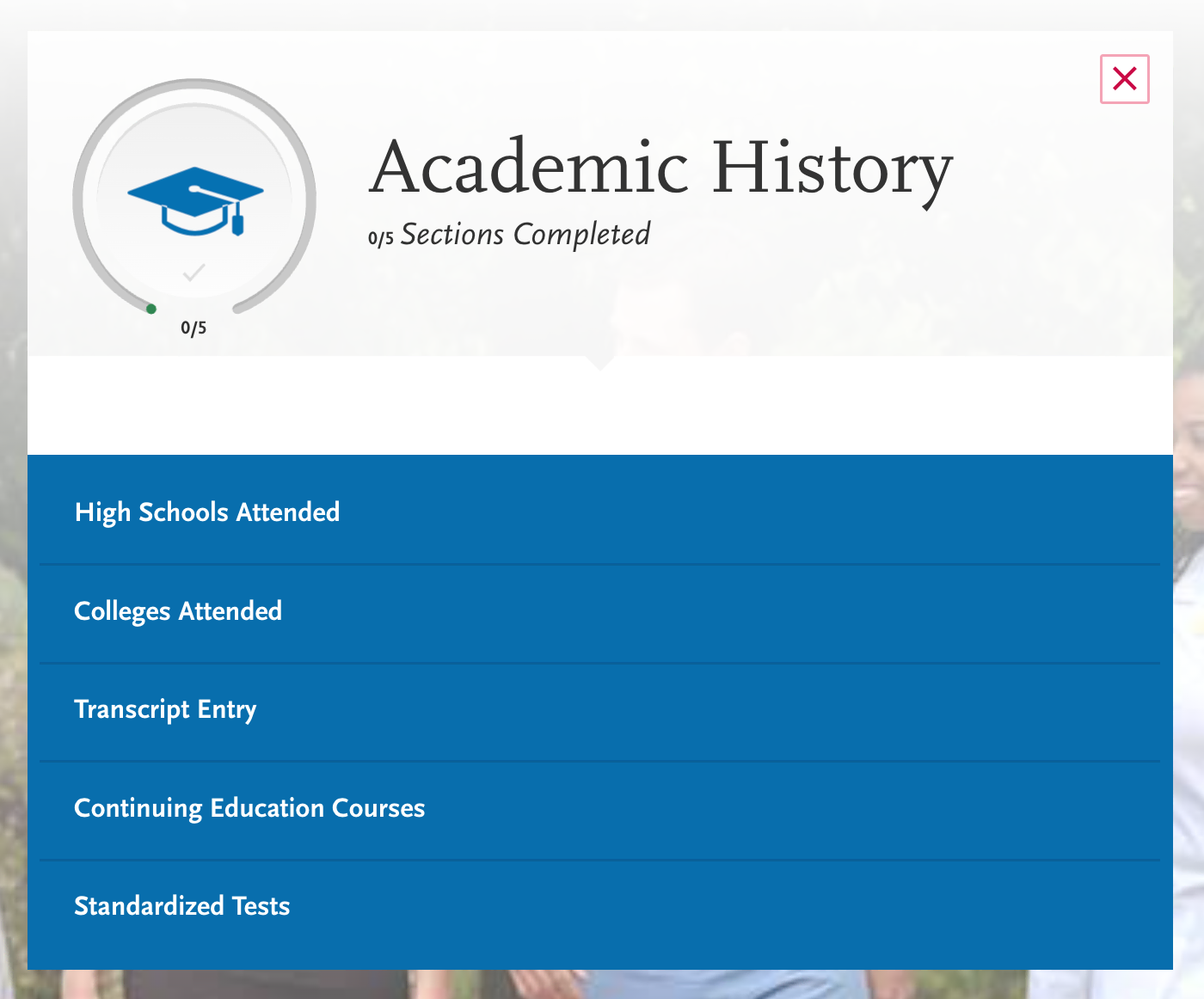
Information about all of your educational experience will be added to one of the 5 tabs in this section:
High Schools Attended: Enter the details of the high schools(s) you went to, when you graduated, and the location of the school.
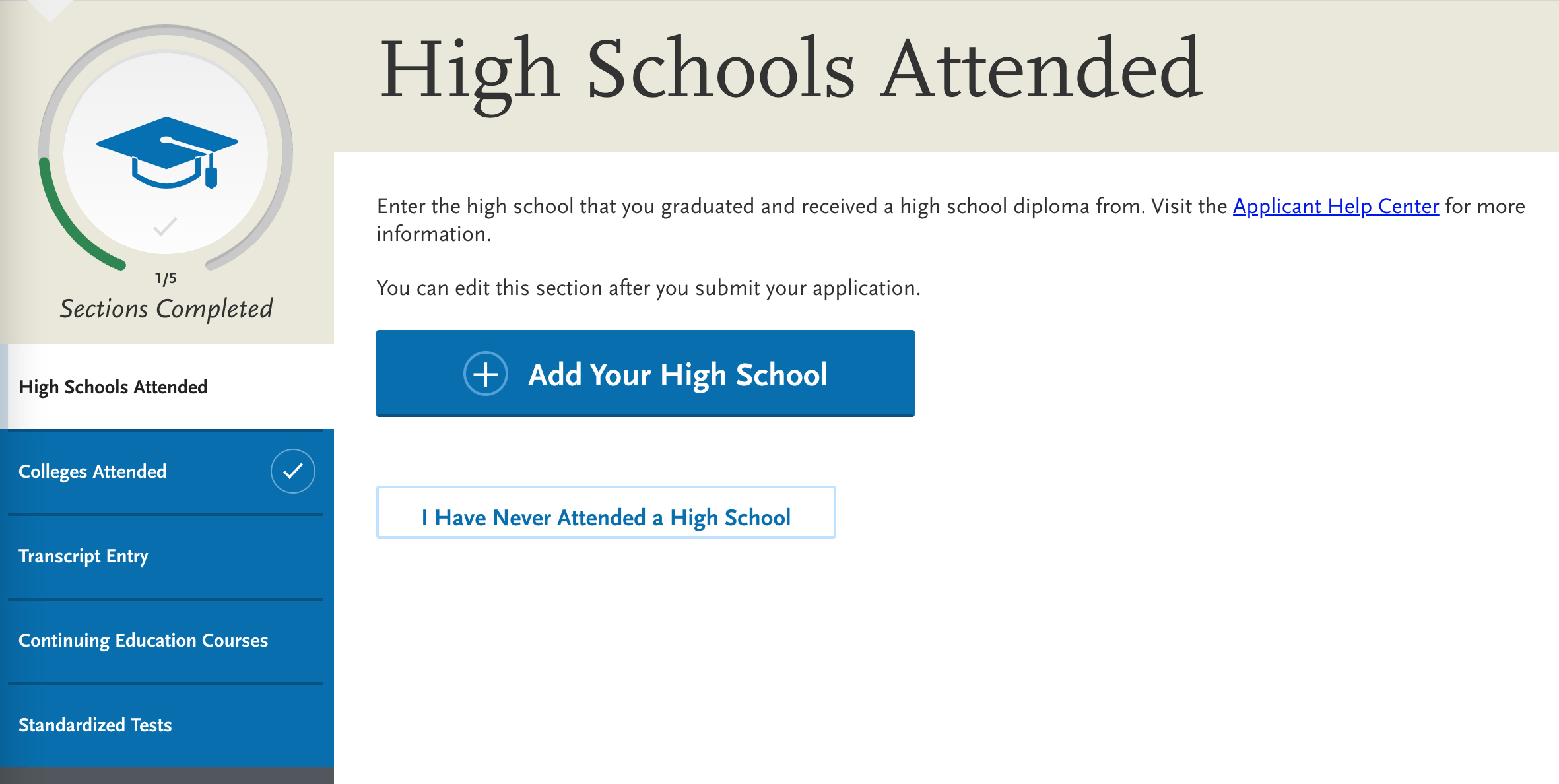
Colleges Attended: Name all colleges and institutions you have attended since high school, including summer courses and US military academies (if applicable). Don’t skip any institutions, even if they seem irrelevant to the program you’re currently enrolled in — this can cause your application verification to fail. For every program you list, you’ll need to send an official transcript.
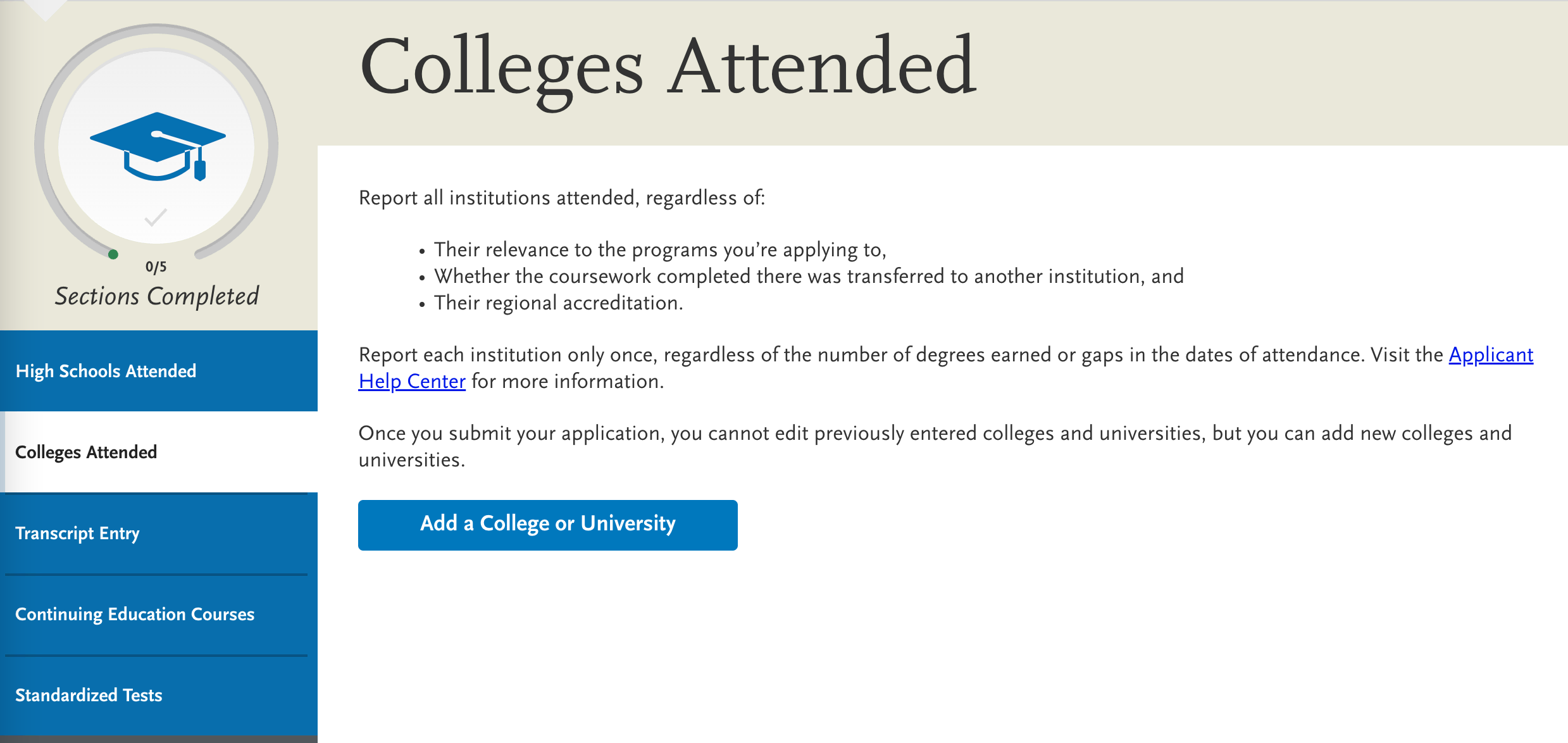
Transcript Entry: Enter all coursework you’ve completed at colleges or universities in the US and Canada. This isn’t just for prerequisites; you’ll need to include every single class you’ve taken, including repeats. You’ll select the appropriate Course Subject for GPA calculation for every class you enter. Ensure the information matches your transcript precisely so that verification will succeed. You can use the AACOMAS Professional Transcript Entry Service (PTE) for a fee if you don’t want to fill out the information yourself.
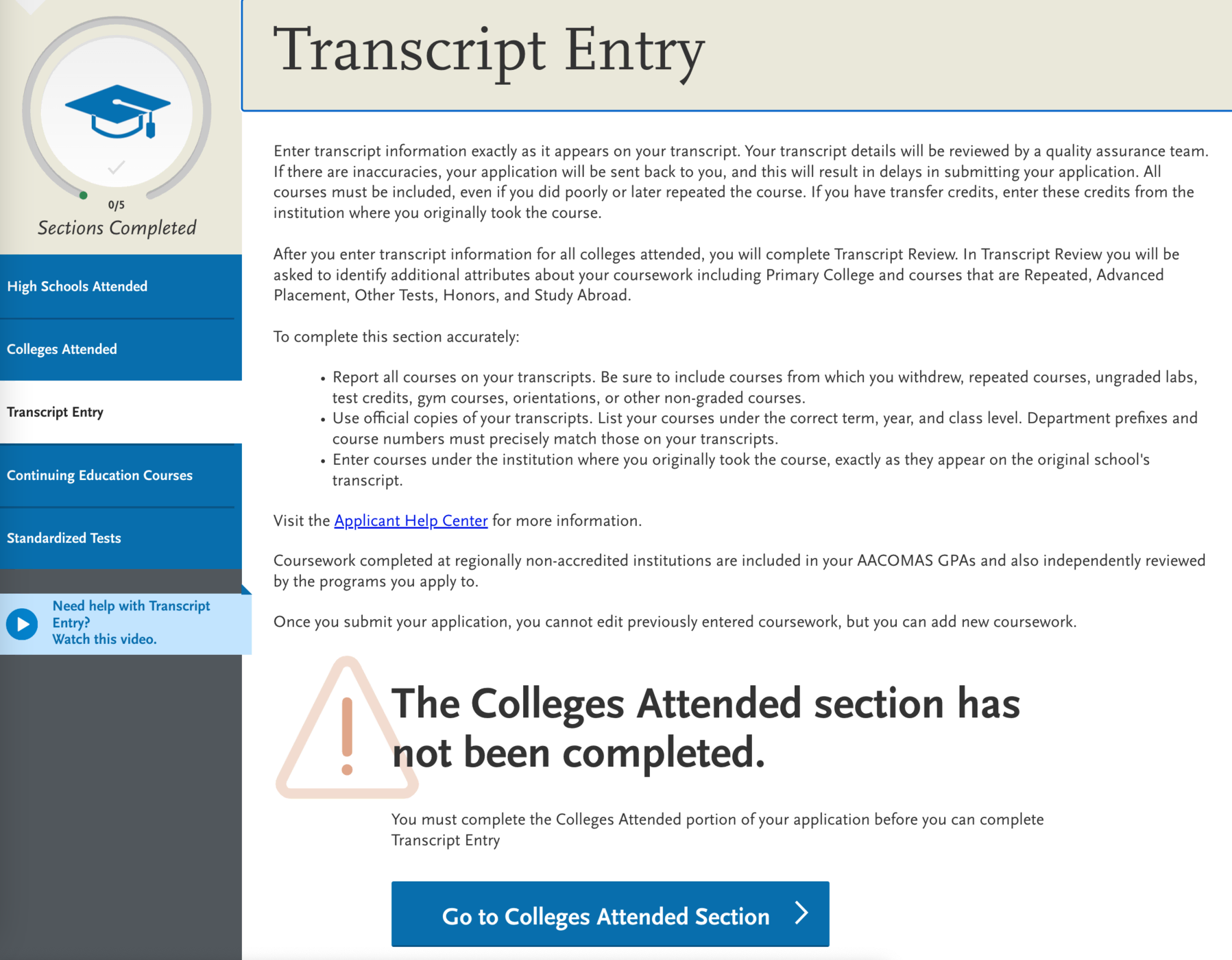
Continuing Education Courses (CE): If you’ve completed CE units, you’ll list those here and upload certificates for each course listed.
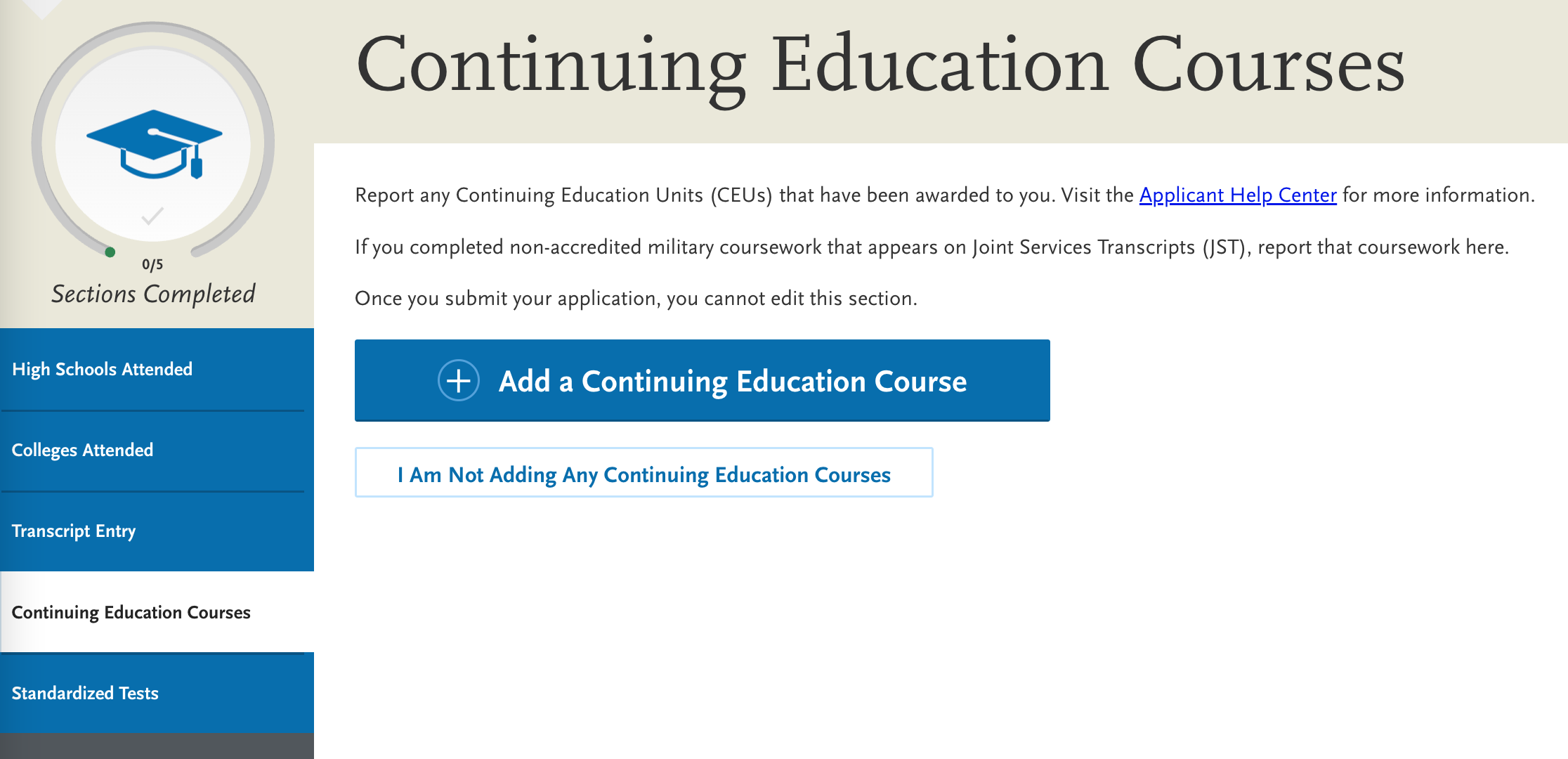
Standardized Tests: Include all standardized test scores you have here, including your ACT, SAT, and/or MCAT exam score. Contact AAMC to request your MCAT scores be released to AACOMAS and ensure your AAMC ID number was filled out correctly in the Other Information section. You’re responsible for ensuring AAMC sends these scores on or after the date that AACOMAS applications open.
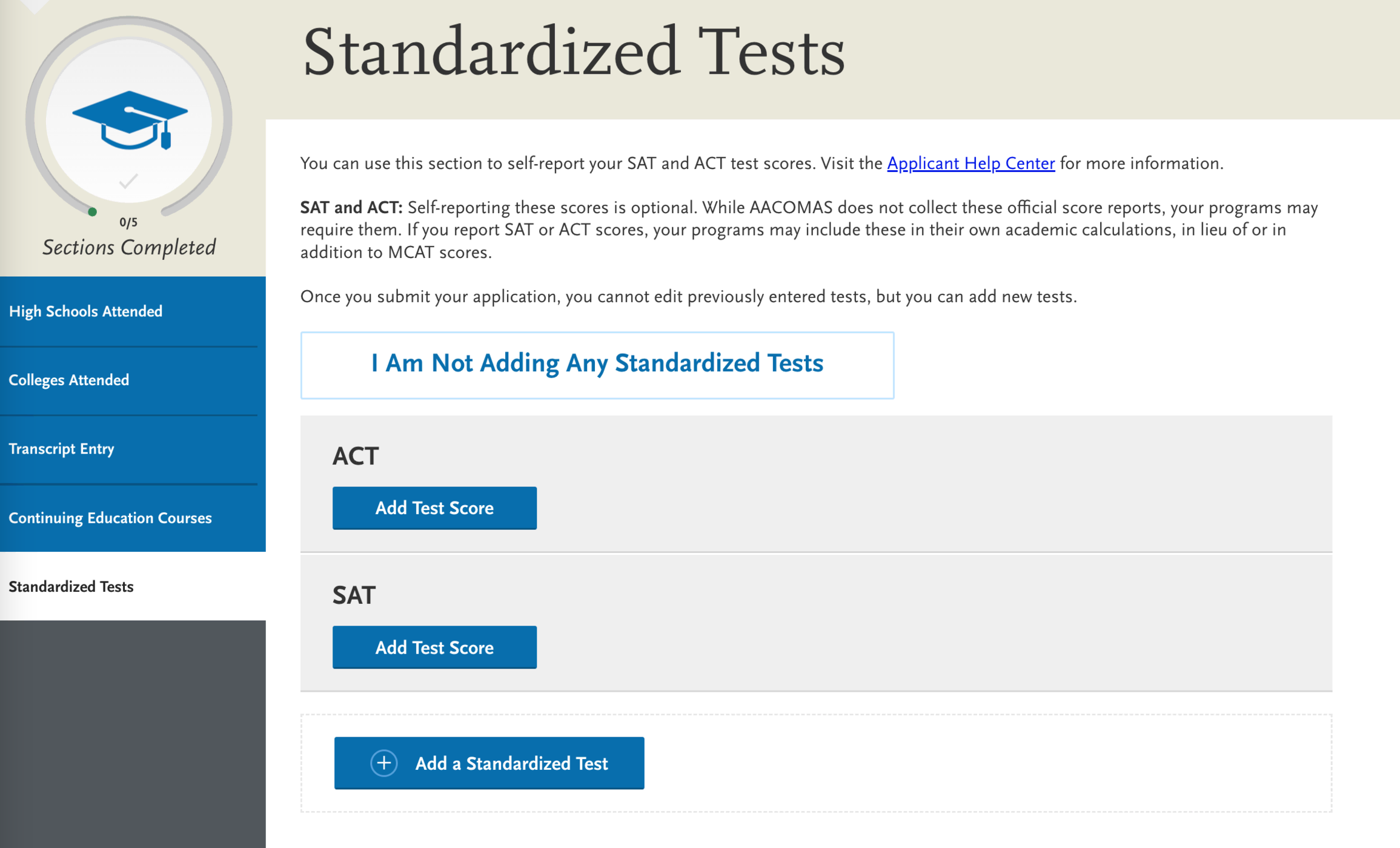
Section 3: Supporting Information
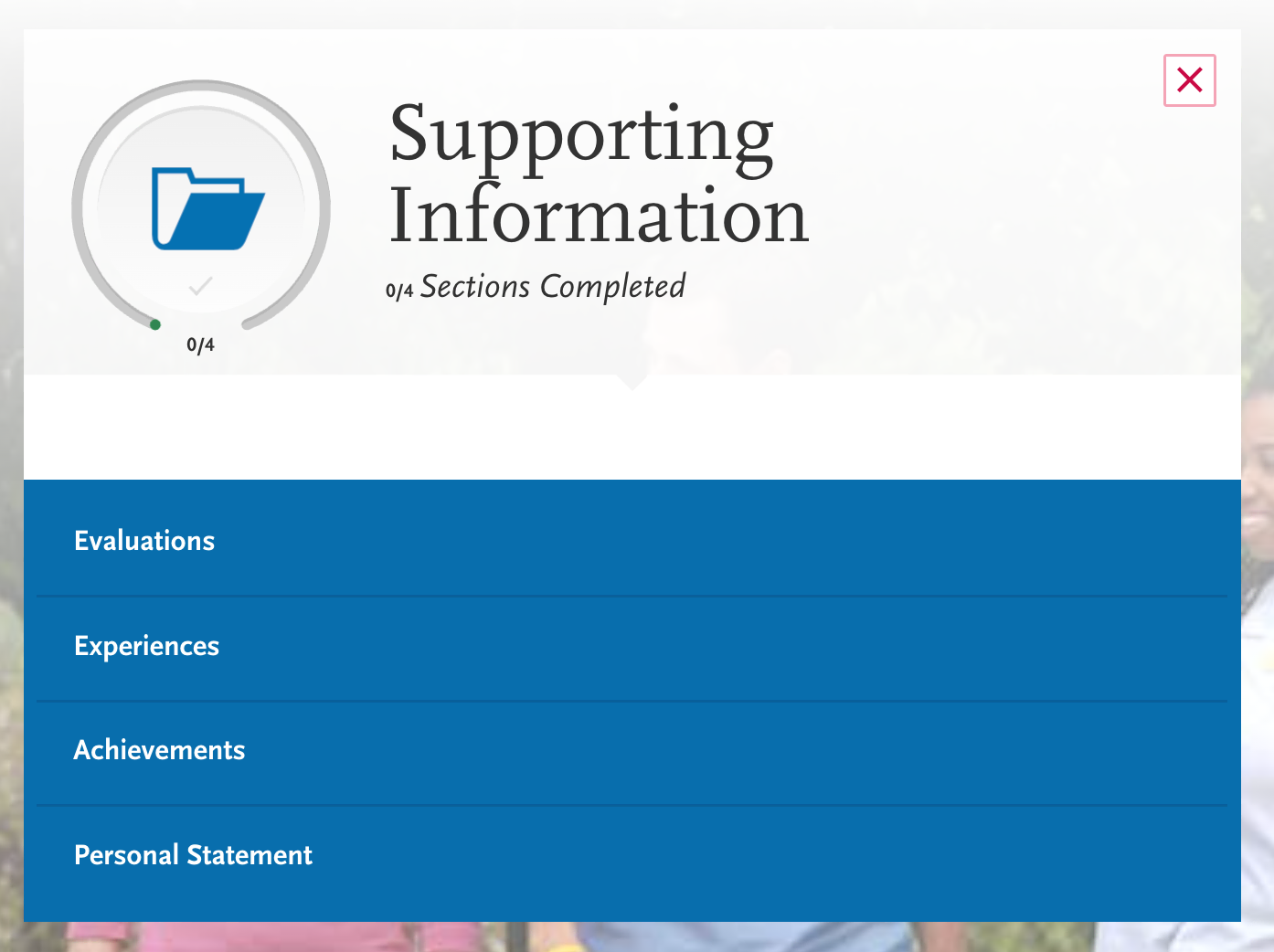
This section is where you get to showcase what makes you a unique and compelling candidate. Here’s what you’ll fill out:
Evaluations: Provide up to 6 evaluators, including email addresses. Include a personal message to each person you choose. Your evaluators will then submit letters of recommendation directly through the Letters by Liaison portal. You can’t submit your own LORs, but it’s your responsibility to follow up with letter writers to ensure this process is completed.
Make sure they check their email for a message from aacomasinfo@liaisoncas.com (it may end up in spam). Dossier services like Interfolio or VirtualEvals can also be a great way to store and release confidential letters like these — just be sure to submit only evaluations for the current application cycle.
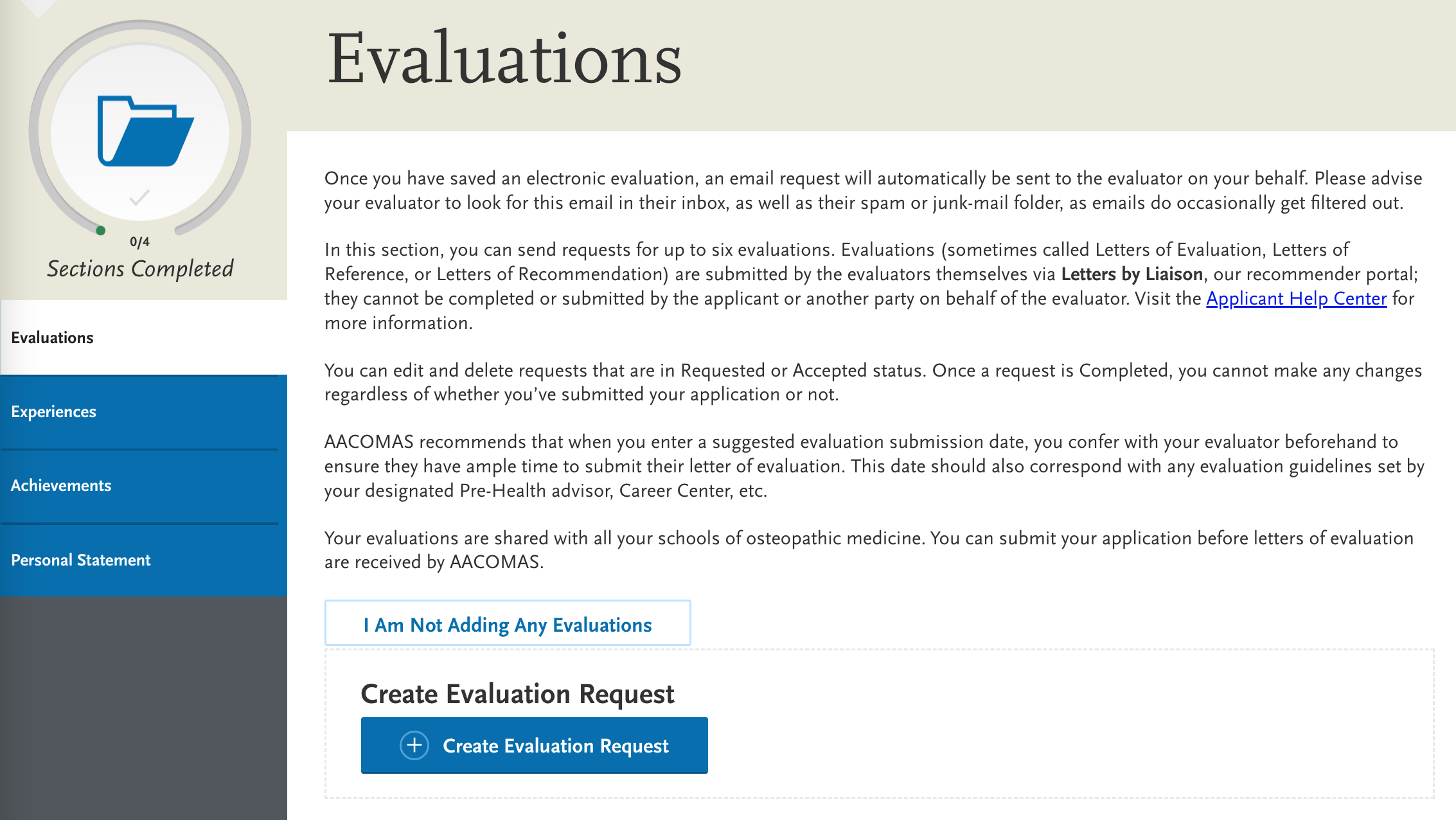
Experiences: There is no limit to how many of these you can add, and each has an entry field of up to 600 characters where you can describe this experience. Select from 4 categories: Extracurricular Activities, Non-Healthcare Employment, Non-Healthcare Volunteer, and Healthcare Experience.
If you have extensive career experience, prioritize experiences from the past 8-10 years. Unlike you’ll find on the AMCAS, there’s not a field for “most meaningful activities,” so be thoughtful about what to include.
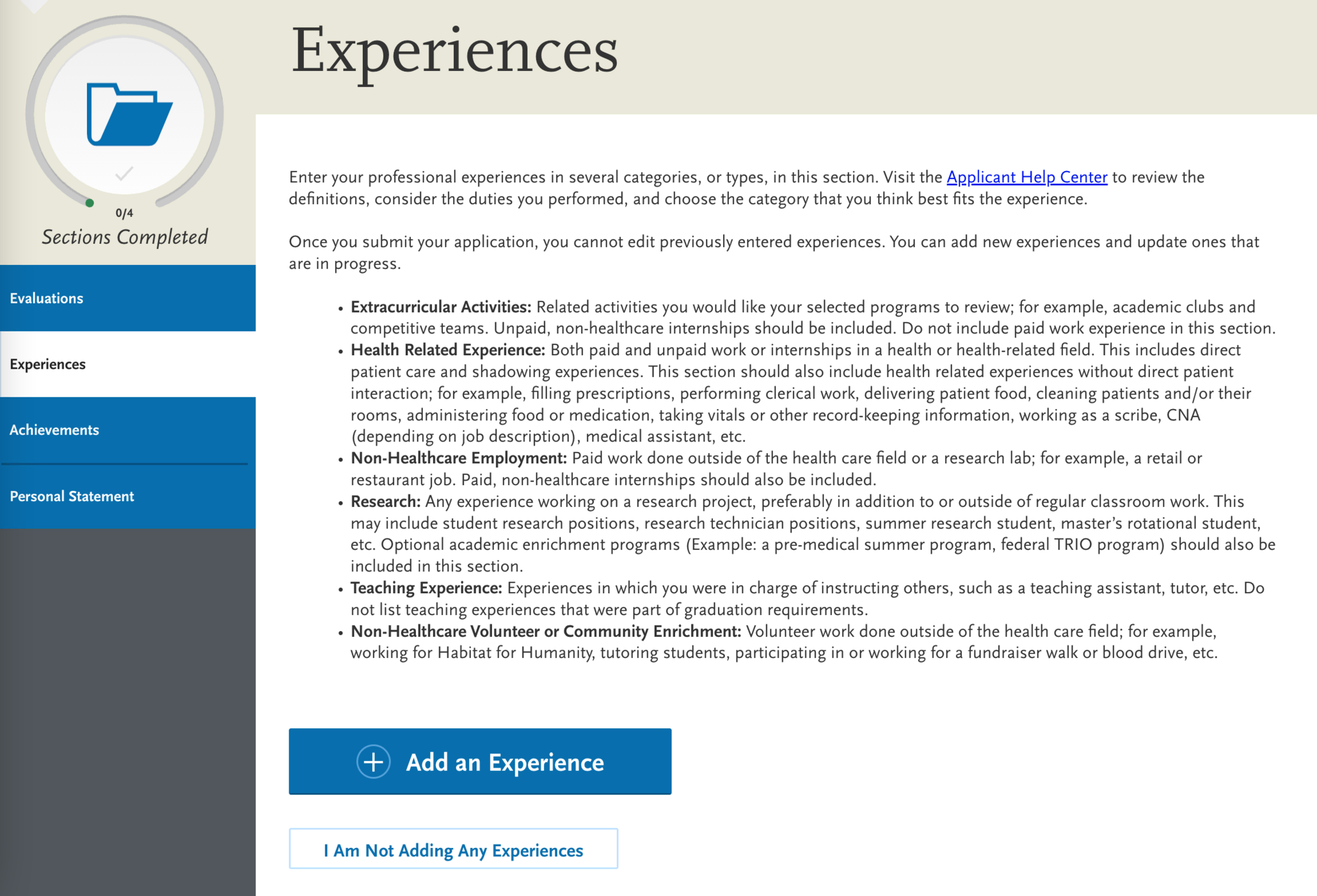
Achievements: Include achievements like scholarships, major presentations, awards, and publications here. If you’re unsure if an achievement is appropriate for your med school application, talk to a trusted mentor or your pre-med advisor.
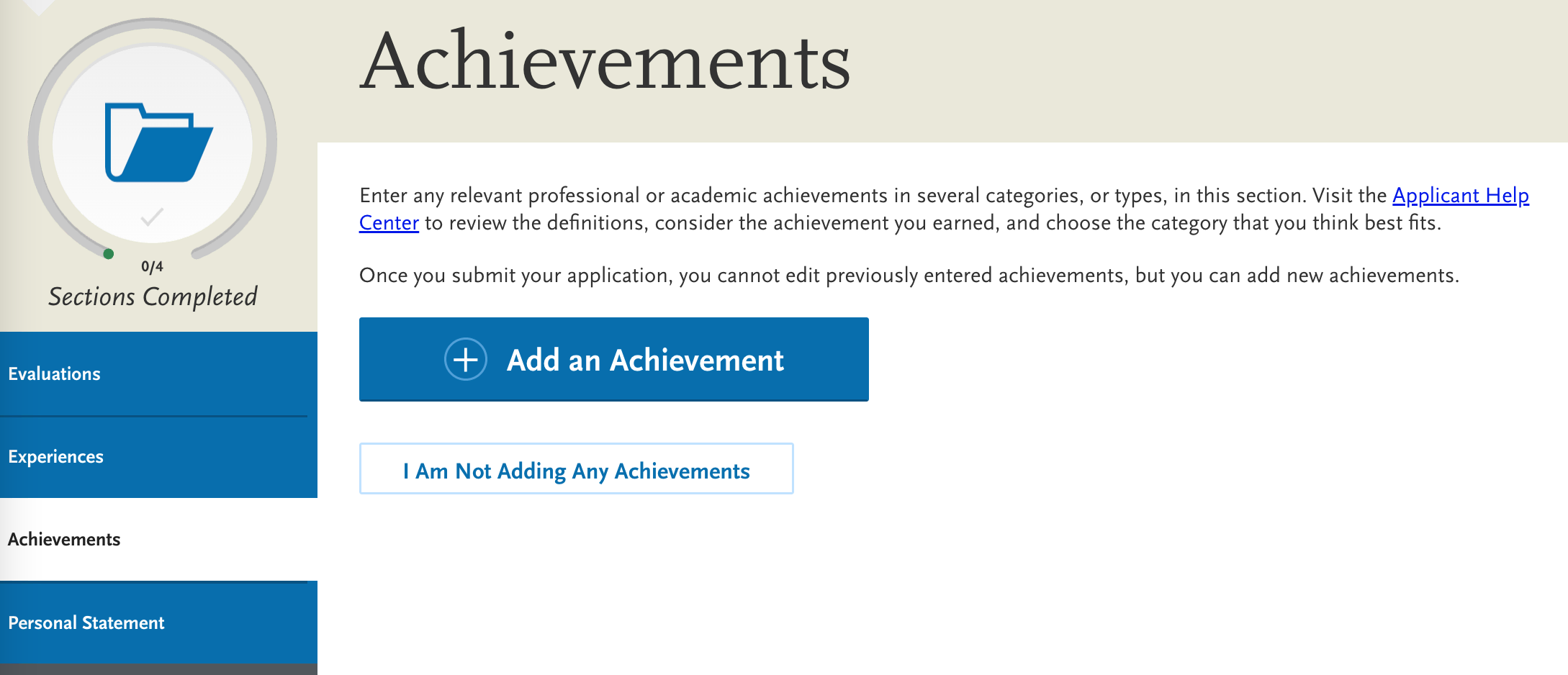
Personal Statement: This is one of the most important sections of your primary application, so proceed with care. Write a story-driven essay to showcase who you are as an individual, describe what motivates you, and demonstrate how your values align with the schools where you plan to apply.
Like the AMCAS, the AACOMAS personal statement limits entries to 5300 characters (about 3 double-spaced pages in standard 12-point Times New Roman). You may not use rich text formatting (bold, italics, etc.). Make sure to thoroughly proofread your essay before submitting it.
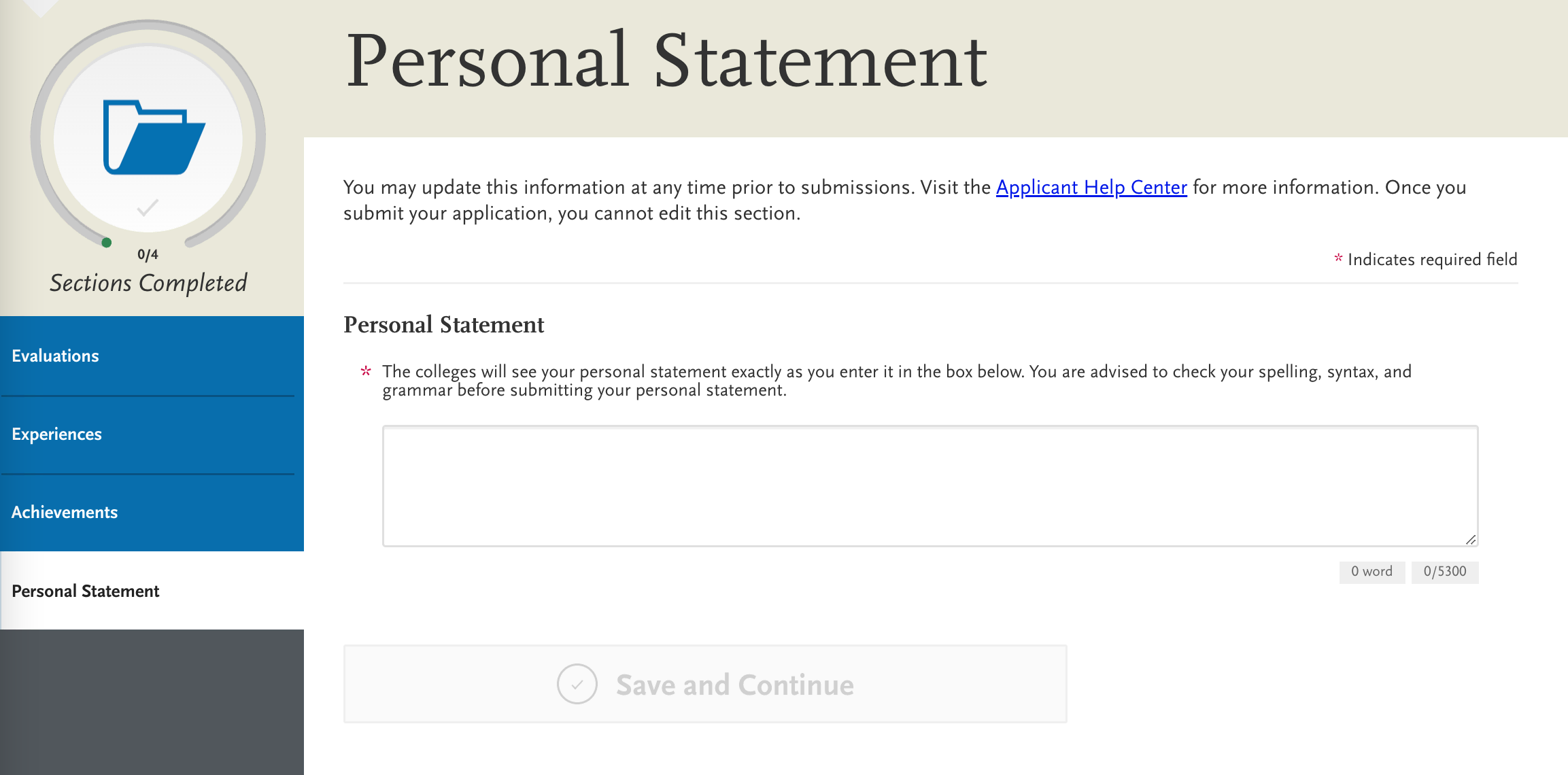
The personal statement can make or break your application. Get support from our Writing Advisors and Physician Advisors to make sure your application stands out from the crowd.
Section 4: Program Materials
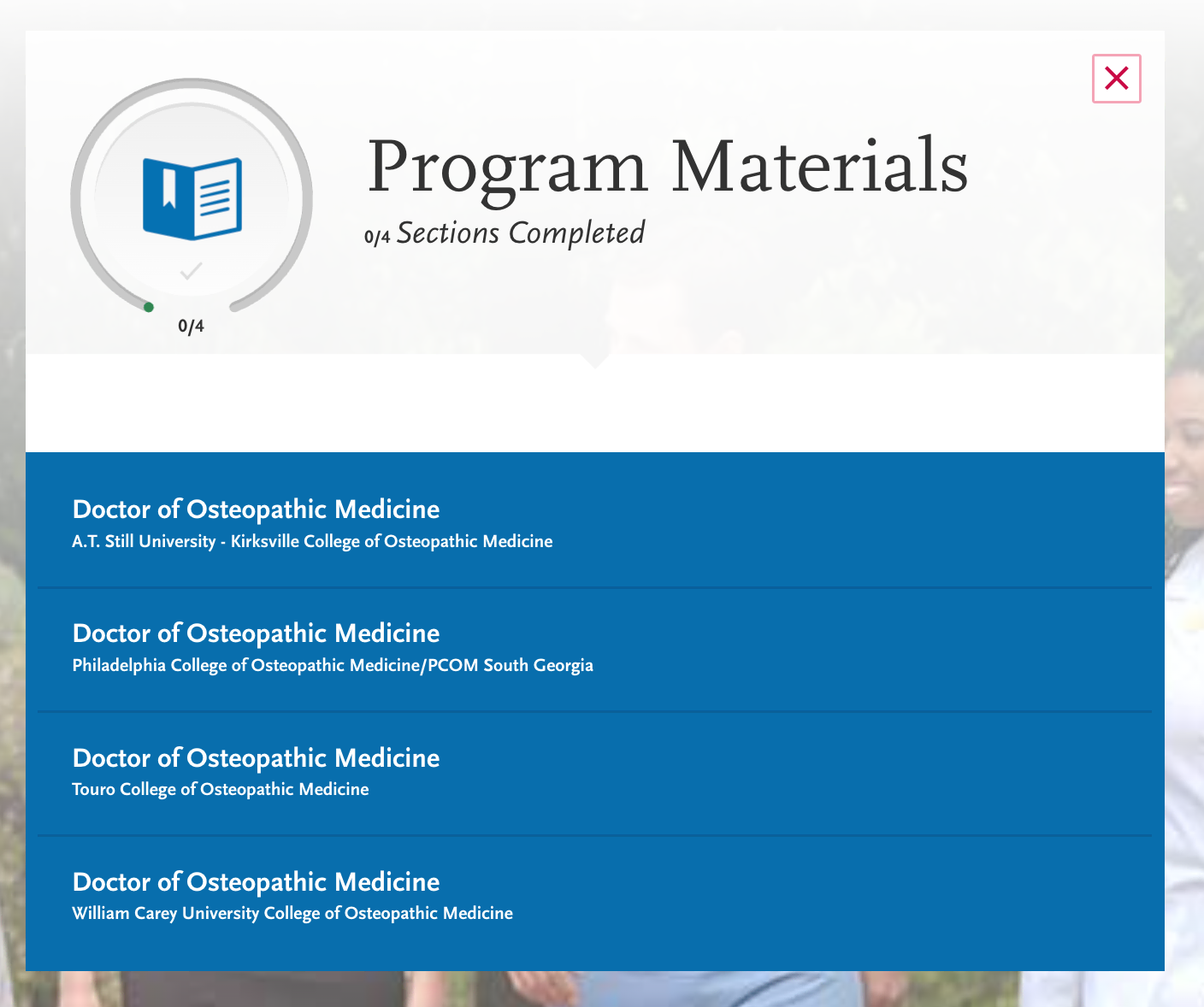
You’ll select the program(s) to which you want to apply in this section or by using the “Add Program” tab at the top of the main application page.
The schools you selected will be shown on the right side of the screen. When you click on the name of the institution, you’ll be able to see what additional prerequisites, requirements, or materials that school requires you to submit before completing your application.
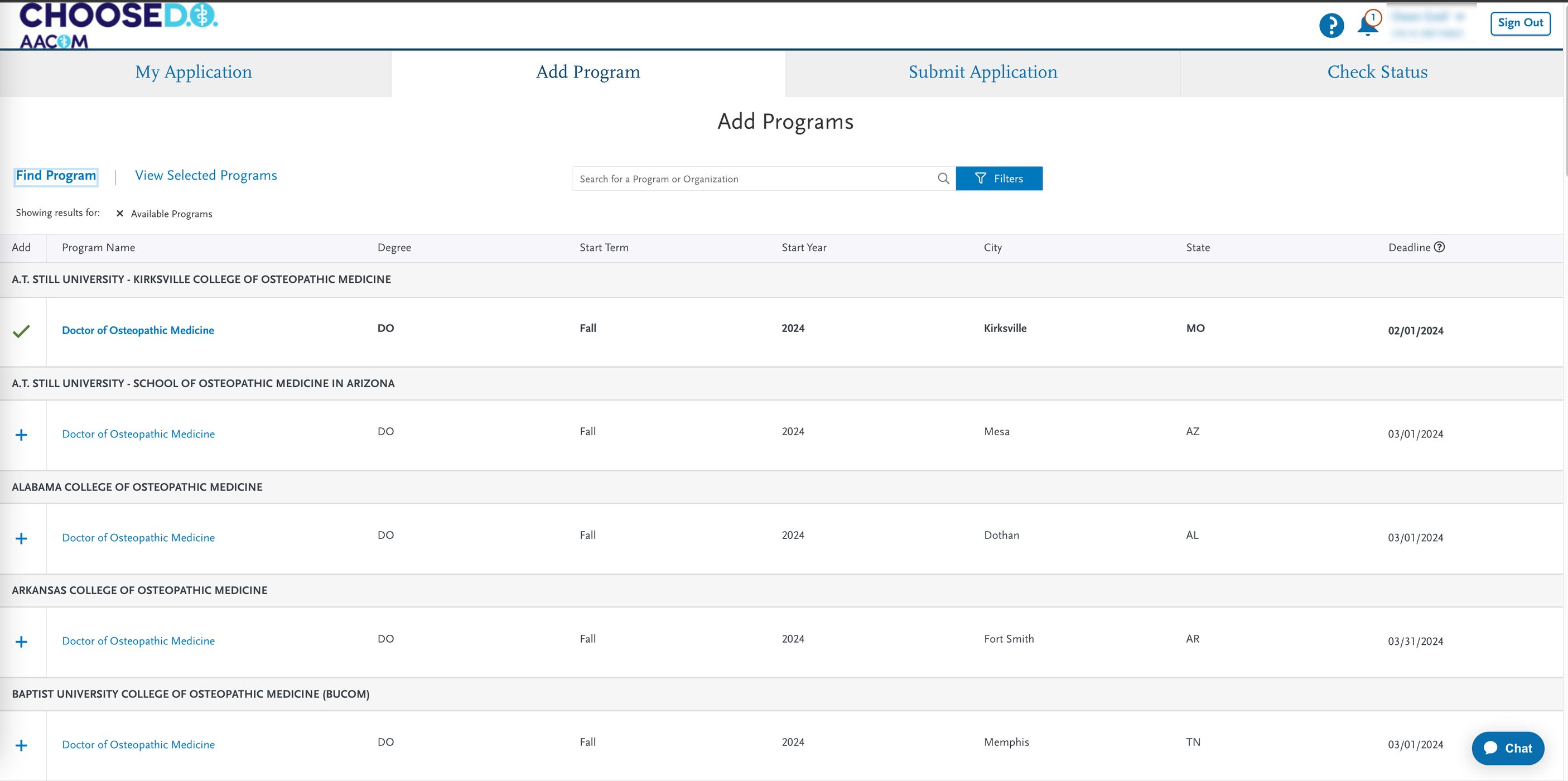
This information differs widely by school. Some of the most common types of information you may need to complete are:
- Questions about yourself (in open-ended text or multiple-choice format)
- PDFs to download (some schools will include secondary essay prompts here)
- Prerequisites
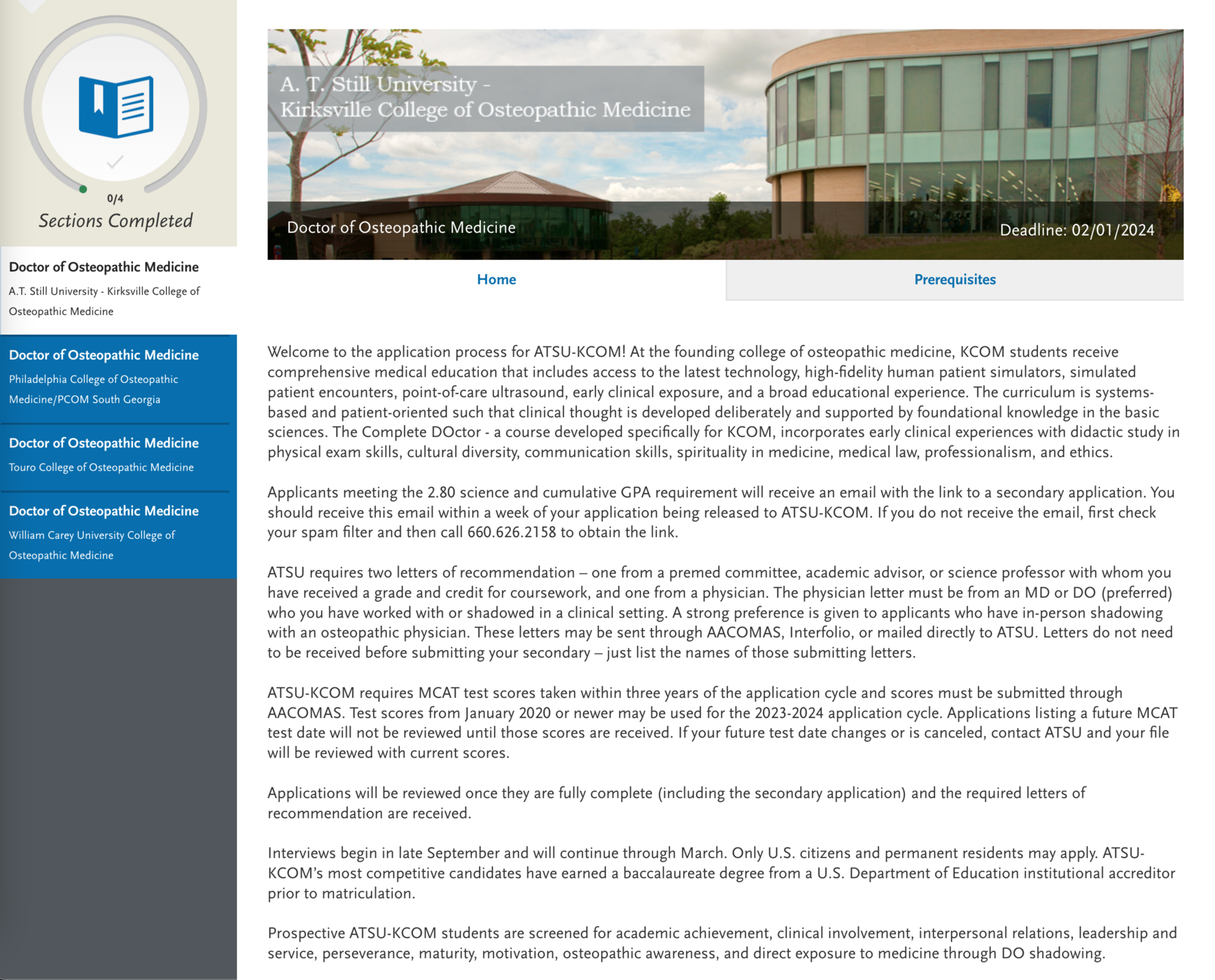
Final Submission and Payment
After you’re confident each section is complete and you’ve met all of the application requirements, it’s time to submit your application. At this point, certain sections and forms will be locked, and you can’t edit them anymore.
The site will ask you a series of certification questions that serve as your official signature.
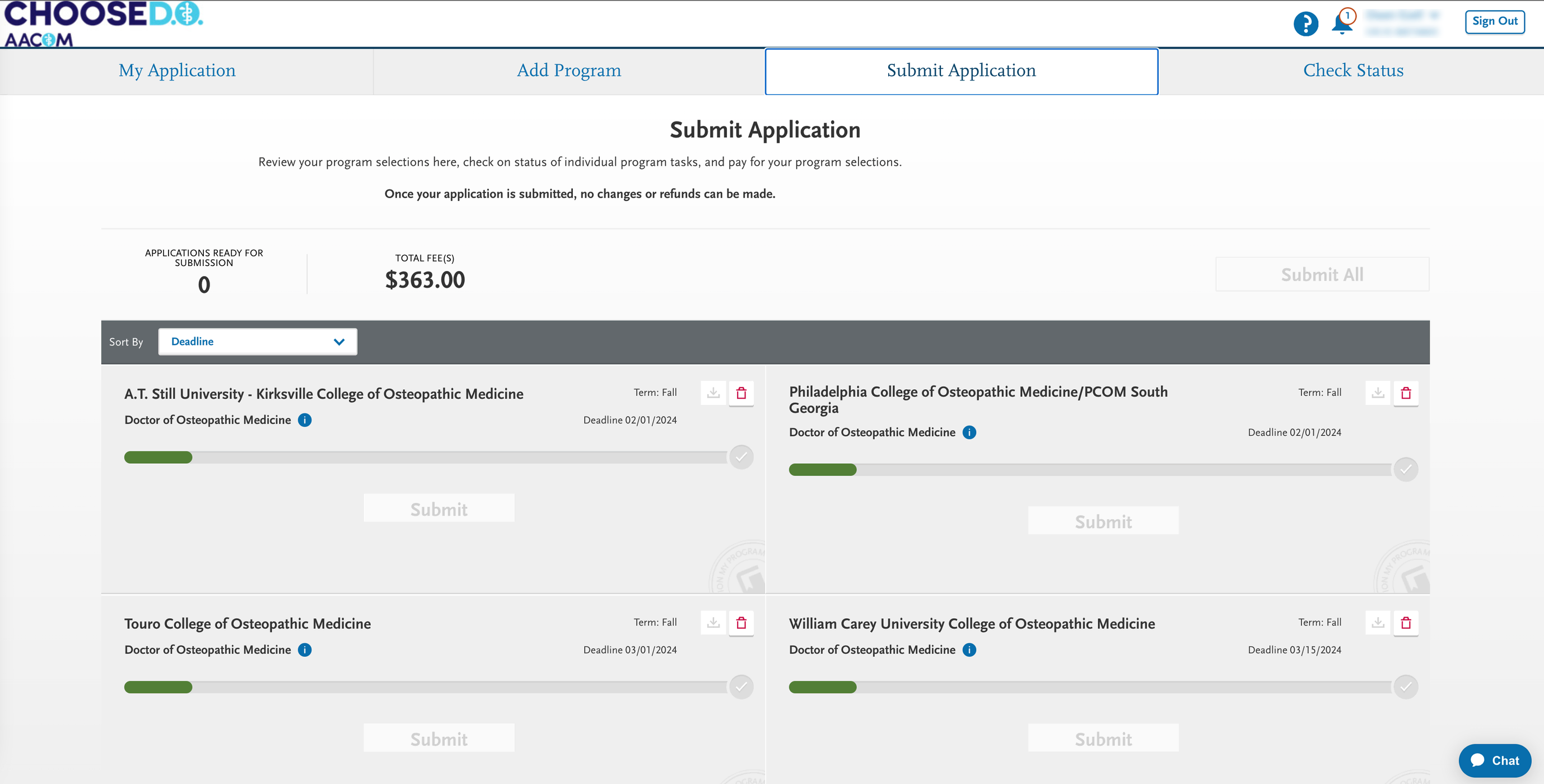
Before submitting, you’ll be able to see what application fees you’re responsible for paying. After the certification process, you can pay the application fees using a credit card or your PayPal account (your application won’t be processed until payment is made). There are no refunds.
Save the email you get from the AACOMAS website confirming your application was completed.
Using the application portal, you can monitor the status of your application as it moves from “In-Progress” to “Received” to “Complete.”
Verification
Admissions committees won’t receive a copy of your application until the verification process is complete. This usually takes about 10 days. If a significant number of errors are discovered, AACOM will return your application to you to make corrections (status “Undelivered”).
Here’s what happens during this time:
- The course subject categories you selected when entering your coursework are checked and corrected, if needed.
- Every course in the Transcript Entry section is converted to an AACOMAS grade value (based on whether it’s considered a science or non-science course).
- These grades are used to calculate your overall and BCPM GPA. These GPA data may not match your official transcript GPA.
- Completed degrees are confirmed as “awarded” (this only applies to prospective medical students who have already completed undergraduate or other degrees beyond high school).
To dispute a course subject category assignment or GPA calculation, email aacomasinfo@liaisoncas.com with a subject line of “Course Subject Correction” or “Verification: GPA Inquiry.” Include your CAS ID # (beneath your name in the right-hand corner of each screen on the AACOMAS portal). These disputes may not be completed via phone.
What Information Can Be Added After Submitting My Application?
Most of your application will be locked and uneditable after you submit, but there are a few areas where new information may be added or edited:
- Experiences and Achievements: You can’t alter existing experiences or achievements, but you can add new ones.
- Program Selections: You may add new programs to which you want to apply. You can also remove a program by hovering over the checkmark next to the program name, clicking it when it transforms to an “X,” and then confirming by clicking “Delete.” There must be at least one program selected at all times.
- Evaluations: New evaluators may be added — for instance, if one of your letter writers backed out, you can request a letter from another individual.
- Biographic Information: You may include new biographical information.
- Coursework: You can’t edit existing coursework, but you can add new entries.
Costs & Fee Waiver
The first program you choose costs an application fee of $198. Each subsequent program costs $55.
If you can’t afford this fee, you may request one of the limited fee waivers offered by AACOM. This waiver covers only the initial application fee of $198 (including a single institution), but you’ll be responsible for paying $55 per additional school you add to your application.
To qualify, your Federal Income Tax Return Form 1040 and your parent or guardian’s 1040 must be below the “Low Income Levels” as defined by the AACOMAS Applicant Help Center. These levels are based on family size and calculated as an income at or below 200% of the US Department of Health and Human Services poverty guidelines.
FAQs
The AACOMAS application is the primary application used for students applying to osteopathic medical schools to pursue a Doctor of Osteopathic Medicine (DO) degree. AMCAS is a similar application for students applying to allopathic medical schools to pursue a Doctor of Medicine (MD) degree.
Yes, you’ll need to submit an MCAT score as part of your application. All osteopathic programs in the US require this standardized test score during the application process. It takes about a month for your MCAT results to be delivered, so aim for an MCAT test date no later than the end of May so you can submit your application by the end of June.
If possible, it’s a good idea to have at least one letter of recommendation from a Doctor of Osteopathic Medicine. However, not having a DO write you an evaluation won’t preclude you from an acceptance.
Each institution’s application requirements are different, but you will typically need:
• One year of physics
• One year of biology
• Two years of chemistry, including organic chemistry
• One year of English
Applicants who successfully matriculate to DO programs via AACOMAS had an average MCAT score of 504.6 in the most recently completed application cycle.
The average overall GPA for entering DO students was 3.61 in 2022. These matriculants averaged a Science GPA of 3.53 and a Non-Science GPA of 3.70.
Want help improving your MCAT score? Our tutoring students increase their scores by 12 points on average. Find out how MedSchoolCoach MCAT tutoring works.
You will receive updates from AACOMAS via email when your transcripts and evaluations are received and your application verification is complete.
DO schools do not offer early decision programs (EDPs) like those offered by some MD programs.
The Professional Transcript Entry Service is only available for coursework completed at an accredited institution. Coursework from a college or university outside of the US must be filled out by the student.
Applications open in May of each year and close the following April. Deadlines for submitting through AACOMAS differ by school but are typically between January and March near the end of the application cycle.
Don’t wait that long — for the best chance at acceptance, you should submit your application no later than the end of June.
Get Help Crafting a Standout AACOMAS Application
Our Advisors have spent over 500,000 hours working with students applying to medical school. Make your dream of a future medical career come true with world-class consulting and support from Day 1 of the application process.
Get comprehensive medical school application consulting from MedSchoolCoach and double your chances at getting a “YES!”

Sahil Mehta MD
Dr. Mehta is the founder of MedSchoolCoach and has guided thousands of successful medical school applicants. He is also a practicing physician in Boston where he specializes in vascular and interventional radiology.



